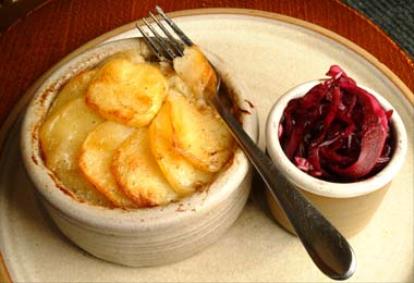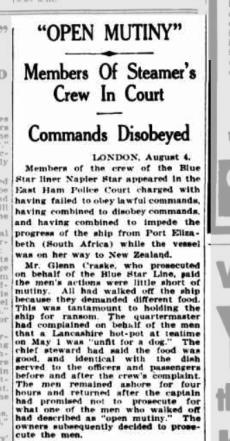

|
 (or Lancashire Hot-Pot, or Hot Pot) Alternating layers of red meat, most usually sheep meat, thinly sliced potato, and onion, the top layer being of overlapping very thin potato rounds. Occasionally with a minor addition of other ingredients such as mushrooms, carrot, leek, oysters. Baked so that the top forms a crust. Served from the pot and accompanied by pickled red cabbage, beetroot or onion.  Image: www.visitlancashire.com In Lancashire, all types of stew (including Scouse) are referred to as ‘hotpot’, but only as ‘Lancashire Hotpot’ when in this form. The name may derive from the earlier usage of ‘hodge podge‘ for a mixed stew, but is unrelated, except in as much as it is hot and in a pot, with ‘hot pot’ as a name for a cup of spiced beer. The first reference we can find is in a letter from ‘A Lancashire Man’ reproduced in the 1795 ‘Annals of agriculture‘ where it is described as being like a poor man’s pie; “consisting of a trifling portion of beef or mutton, either raw or boiled, cut into small pieces and mixed in a dish of sliced potatoes, proportioned to the size of the family, to which you add pepper and salt and a little water with butter or dripping, as gravy, the wholesome and savoury addition of a shred onion is often made, and gives a good relish. The dish of hot-pot, or lob scouce as termed by sailors, is composed of the same ingredients except a crust and that it is simmered over the fire in a pan or in a pipkin in an oven.” The earliest full receipt we can find (with thanks to Rodney Keeble) pretty-much follows the modern usage, but does not specifically associate the dish with Lancashire…  Original Receipt from ‘The English cookery book, receipts collected by a committee of ladies‘, ed. by J. H. Walsh, 1859 (Walsh 1859) Original Receipt from ‘The English cookery book, receipts collected by a committee of ladies‘, ed. by J. H. Walsh, 1859 (Walsh 1859)Hot-Pot. 399. Take some fine chops from a neck of mutton, and trim them nicely, taking off most of the fat. Lay them at the bottom of a deep and rather wide dish, and season them with pepper and salt. Lay a few slices of an onion in the middle at the bottom of the dish, if the flavour is approved and pour a quarter of a pint of cold water upon the whole. Then cover it with a layer of sliced potatoes, on the top of which lay a few more small chops, well-seasoned, and cover all with another layer of sliced potatoes. Bake from an hour to an hour and a half or more, according to the size of the dish; in a very moderate oven.  Original Receipt from ‘Whitstable Times and Herne Bay Herald‘ – Saturday 29 October 1892 Original Receipt from ‘Whitstable Times and Herne Bay Herald‘ – Saturday 29 October 1892“Lancashire Hot Pot” is made of mutton chops and potatoes cooked in a crock. First a layer of potatoes, then of mutton seasoned with pepper and salt, mushrooms being added, if convenient, and so on until the crock full. On the top the potatoes are cut small, in order that they may brown. To make the dish less rich, partly cook the mutton before putting into the crock. In ‘Dinners and dinner-parties‘ by ‘G.V’ of 1862 hotpot is described as; “A Lancashire dish, much liked; so much so, that every one at table always partakes of it, and most persons make their dinner of it,” adding that; “A few larks or snipes are a great addition.”  Original Receipt from ‘Exeter and Plymouth Gazette‘ – Friday 2 September 1904 Original Receipt from ‘Exeter and Plymouth Gazette‘ – Friday 2 September 1904For the famous Lancashire hot-pot a strong earthenware pan is required. Butter the pan well. Have plenty boiled potatoes, cut in slices, and put a layer the bottom, and next put a layer of fresh rump steak and either kidneys or oysters. Pepper and salt these. Then another layer of sliced potatoes, then more so on alternate layers, with a top layer of potatoes. Before putting this on, pour in a little stock or water, and, desired, an onion cut very thinly on the meat. Put pieces butter the top, and: bake a nice brown.  Original Receipt from ‘The Queen Book of Meat and Game‘ (1902) Original Receipt from ‘The Queen Book of Meat and Game‘ (1902)The famous “Lancashire hotpot” is made thus, though with slight variations. The cutlets are trimmed, seasoned, and laid in first into the lightly buttered “pot,” then a good layer of seasoned sliced kidneys, very thinly sliced onion, bearded oysters, and sliced, parboiled potatoes, sprinkling this layer with a small teaspoonful of curry powder (this is a matter of taste), and repeat these layers, finishing with potato, which, however for this should be only halved, than add the oyster liquor, and a little good gravy, and bake it all in not too fierce an oven, till the top lay(»r of potatoes is cooked and nicely browned. Add a little more hot gravy before serving. In every case these hotpots are improved by being stood whilst baking in a tin of boiling water, and being covered with a buttered paper. This dish can be made of almost anything, and is equally good with cut up poultry, rabbit, &c.;  Not everyone likes Lancashire Hotpot. In 1939 the crew of the Napier Star liner were each given six weeks in prison after mutinying because they were served Lancashire hotpot instead of their preferred bacon and eggs. See also: Bolton Hotpot Chiddingly Hot Pot Essex Hotpot Scouse or Lobscouse Tatie Pot Vegetable Hot Pot  |
|
MORE FROM Foods of England... Cookbooks ● Diary ● Index ● Magic Menu ● Random ● Really English? ● Timeline ● Donate ● Royalty ● English Service ● Food Map of England ● Lost Foods ● Accompaniments ● Biscuits ● Breads ● Cakes and Scones ● Cheeses ● Classic Meals ● Curry Dishes ● Dairy ● Drinks ● Egg Dishes ● Fish ● Fruit ● Fruits & Vegetables ● Game & Offal ● Meat & Meat Dishes ● Pastries and Pies ● Pot Meals ● Poultry ● Preserves & Jams ● Puddings & Sweets ● Sauces and Spicery ● Sausages ● Scones ● Soups ● Sweets and Toffee ● About ... ● Bookshop ● Email: [email protected] COPYRIGHT and ALL RIGHTS RESERVED: © Glyn Hughes 2022 BUILT WITH WHIMBERRY |